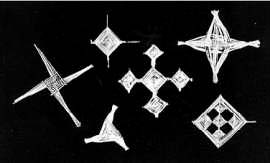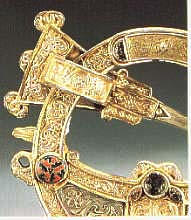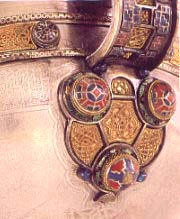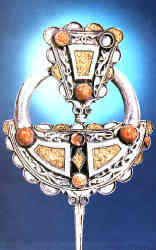Saints
St. Patrick's Confession is a historical document which affords a glimpse of how Ireland appeared to an outsider in the fifth century AD. Of noble birth and a native of England, Patrick tells how he was kidnapped by Irish traders and enslaved at sixteen years old. Several years later he escaped to the Continent where he was ordained priest and bishop and then returned to Ireland where he converted many women and men to Christianity.
|
And the Irish leaders' sons and daughters are seen to become the monks and virgins of Christ. Indeed on one occasion this happened. A blessed Irish woman of noble birth, a most beautiful adult whom I had baptised, came back to us a few days later for this reason. She told us how she had received a divine communication from a messenger of God which advised her to become a virgin of Christ and that she should move closer to God. Thanks be to God, six days after that she avidly and commendably took up that life which is lived by all who are virgins of God. This is, of course, not to the liking of their fathers and they have to suffer persecution and false accusation from their parents. Yet, despite this their number keeps increasing and we do not know the number of those born there from our begetting - apart from widows and those who are celibate.
But of all these women, those held in slavery have to work hardest; they are continually harassed and even have to suffer being terrorized. But the Lord gives grace to many of his maid-servants, and the more they are forbidden to imitate [the Lord], the more they boldly do this.
St Patrick, Confession, fifth century AD. Translation from Thomas O'Loughlin, Saint Patrick: the man and his works, London, 1999,
p. 78.
|
We may infer from St. Patrick's Confession that:
- some women of independent mind defied their families and slave-owners to become Christians.
- Patrick had sympathy with women slaves, especially perhaps because he himself had been a slave. Early Irish Christian preachers opposed slavery and baptised slaves but references to slaves in laws, literature and saints' lives show that they continued to be of economic importance for some time.
- virginity is strongly emphasised - and would be for the future. According to the early Irish Penitentials, sexual sins and offences, especially by clerics and nuns, were harshly punished with bread and water and other strict regimes.
- Patrick's humility expressed elsewhere in his writings, is in contrast with the boastfulness of many characters in early Irish myths and legends.
I Patrick, am a sinner, an uneducated man, the least of all the faithful and greatly despised by many.
St. Patrick, Confession, 5th century AD. |
The Irish converted steadily to Christianity over the centuries and in time a new way of thinking developed, based on belief in one God and his son Jesus Christ. Bible stories were now told side by side with the old myths and another form of story telling emerged: the lives of the Irish saints, now called hagiography. Many contain important historical information, often concealed behind miraculous and unlikely events.
- St. Brigid, one of the three patrons of Ireland with Patrick and Colmcille, was the most important Irish woman saint. Powerful abbess of a double monastery of nuns and monks in Kildare, she was reputed to have been ordained bishop. Many fascinating stories are told about her, some historic, some fairy tale and others probably based on the pagan triple goddesses named Brigid. Like them, she tended a sacred fire in Kildare. Crosses are made from rushes or straw every year for the feast of St Brigid which falls on the first of February, once the pagan spring festival of Imbolc. A distinctive style may be associated with a particular part of the country.

Brigid crosses
National Museum of Ireland |
- St. Ita founded a community and school at Killeedy, Co. Limerick, where she educated St. Brendan the Navigator.
- Attracta, patroness of the diocese of Achonry, received the veil from St. Patrick, founded a convent at Killaraght, Co. Sligo and was said to have healing powers.
- Darerca also called Moninna, founded a convent at Killeevy, Co. Armagh which was second in importance only to that at Kildare. She studied theology, established other convents in Ireland, Scotland and England and travelled to Rome.
- Dympna, patroness of those concerned with mental illness, is revered at Gheel, near Antwerp in Belgium, a centre for psychiatric treatment. Local tradition says she came from Ireland. She may be the St. Damhnait from Monaghan whose crozier is in the National Museum.
- Líadana, mother of St. Ciaran of Seir Kieran, Co. Offaly founded a convent near her son's monastery. Ciaran dealt firmly with a local chieftain who kidnapped one of her young nuns.
Many lives of the saints came to be embroidered with extraordinary and unreal details, such as dubious miracles, magic tricks and malicious curses. Was it that story tellers and their audiences liked or needed these fantastic details? Did people believe them? Did some monks use them as propaganda to attract pilgrims and donations to the monasteries of their founders? One way or another, they hold a certain fascination for those who 'read between the lines' and try to sift out fact from fiction.
- St. Brigid's cloak got wet while she was out herding sheep and she hung it on a sunbeam to dry.
- St. Íte fondled and nursed the infant Jesus every night.
- St. Ailbe caused a shower of sweet apples to fall from heaven over a barren orchard.
- St. Darerca blessed a poor man's beer barrel so that it provided an endless supply of beer ever after.
- Adomnán found a nursing mother beheaded on a battlefield, put back on her head and restored her to life.
- Adomnán's mother, Ronnat, buried him in a chest of stone in Raphoe, so that maggots ate the root of his tongue and the slime of his head burst out through his ears to persuade him to issue Cáin Adamnáin for the protection of women.
- The voice of St. Colmcille scared a monster back into Loch Ness.
- St. Ruadhan's curses caused the downfall of Tara.
Beautiful women are sometimes presented as temptresses and seducers of celibate monks in folklore and in early Christian Irish literature.
Increasingly as we enter Ireland's Golden Age of Sanctity there is a preoccupation with male chastity,... the white martyrdom. Gradually, Irish women were regarded as seductresses, temptresses and the cause of man's downfall.
Margaret MacCurtain in The Crane Bag of Irish Studies, Dublin, 1982, p. 541. |
- St. Kevin fled to Glendalough so he could escape from the sound of sheep and cows which reminded him of women, sin, the devil and hell.
- St. Máedóc objected to women washing in his spring and, having stuck a king's daughter to the ground like a statue, would not release her until her father begged him.
- The love story of Liadan and Cuirithir tells in verse how Liadan, a poetess and nun, died of grief for the love of Cuirithir. Both had vows of virginity.
Amazing examples of craftwork in metal, stone, calligraphy and illumination produced during the early Christian period have survived and it must surely be the case that textiles, including needlework of similar style and quality were produced but perished with other non-durable materials such as wood and, indeed, food.
 |
 |
 |
|
Tara brooch
Detail from back
National Museum of Ireland
|
Ardagh chalice
Detail of handle
National Museum of Ireland
|
Roscrea brooch
National Museum of Ireland
|
Questions
- Identify three features of the character of St. Patrick, that might have made him successful in his mission, in your opinion.
- Identify three similarities between St. Brigid and the pagan triple goddesses named Brigid.
- What needs might have been served, in your opinion, by adding such fantastic details to the lives of the saints?
- Identify three pieces of evidence for an extraordinary emphasis on virginity at the time.
- Suggest possible reasons for the emphasis on virginity at that time.
Activities
- Role play a conversation between St. Patrick and one of the women mentioned in his Confession.
- Discuss the idea that Ireland was converted to Christianity by persuasion rather than by force.
- Research a personal name or surname derived from an Irish saint.
- Research the life of a local woman saint.
- Suggest ideas for celebrating the feast day of an Irish woman saint.
- Make traditional Brigid crosses for the feast of St. Brigid on 1st February.
- Research the use of Celtic design in needlework>
- Write an essay on one of the following:
a) Story telling in early Christian Ireland
b) Contrasts between the old Irish culture and the new Christian culture
c) Fantasy in the lives of the Irish saints
d) Women in early Christian Ireland
e) The extent to which these stories reveal the culture of the time.
- Select any one of the following aspects of twentieth century culture and pretend to be a historian in the year 3500 AD discussing our culture:
science fiction; thrillers; murder stories; war films; cartoons; pornography; computer games; soaps; women's magazines; tabloid newspapers; sports pages.
- Study 'Women in the AFM' at the end of this section.




